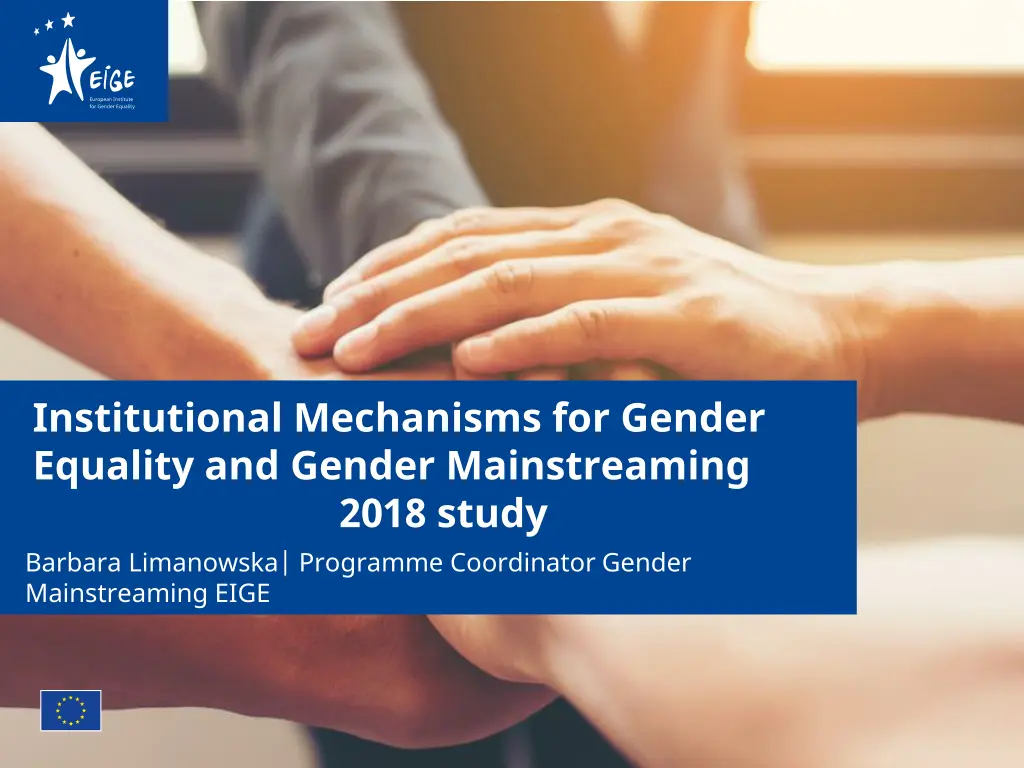
Gender Equality and Mainstreaming Institutional Mechanisms Study 2018
Explore the 2018 study by Barbara Limanowska on institutional mechanisms for gender equality and mainstreaming. The study focuses on objectives such as strengthening national machineries, integrating gender perspectives in policies, and generating gender-disaggregated data for planning and evaluation. It also includes indicators and sub-indicators on governmental responsibility, personnel resources, gender mainstreaming, and data dissemination. This study aims to collect updated information on gender equality mechanisms in EU-28 Member States to enhance monitoring and evaluation tools.
Uploaded on | 0 Views
Download Presentation

Please find below an Image/Link to download the presentation.
The content on the website is provided AS IS for your information and personal use only. It may not be sold, licensed, or shared on other websites without obtaining consent from the author. If you encounter any issues during the download, it is possible that the publisher has removed the file from their server.
You are allowed to download the files provided on this website for personal or commercial use, subject to the condition that they are used lawfully. All files are the property of their respective owners.
The content on the website is provided AS IS for your information and personal use only. It may not be sold, licensed, or shared on other websites without obtaining consent from the author.
E N D
Presentation Transcript
Institutional Mechanisms for Gender Equality and Gender Mainstreaming 2018 study Barbara Limanowska| Programme Coordinator Gender Mainstreaming EIGE
Area H of the Beijing Platform for Action: institutional mechanisms for gender equality and gender mainstreaming The three strategic objectives are: Create or strengthen national machineries and other governmental bodies H1 Integrate gender perspectives in legislation, public policies, programmes and projects. H2 Generate and disseminate gender- disaggregated data and information for planning and evaluation. H3
Indicators INDICATOR 1 Status of governmental responsibility in promoting gender equality INDICATOR 2A, 2B Personnel resources for gender equality INDICATOR 3 Gender Mainstreaming INDICATOR 4 Production and dissemination of statistics disaggregated by sex
Objectives of the study Collect up to date information on the institutional mechanisms for gender equality and gender mainstreaming in each of the EU-28 Member States Contribute to the improvement of the monitoring/evaluation tools for these three objectives Literature overview and survey
Indicator 1 Status of governmental responsibility in promoting gender equality: 2018 10 9 8 7 6 5 4 3 2 1 0 DE LT LU PT SI SK BG CY ES FI IE LV SE UK AT NL PL BE DK EE RO CZ MT EL FR IT HUHR Sub-indicator A Sub-indicator B Sub-indicator C Sub-indicator D Sub-indicator E
Indicator 1 Status of governmental responsibility in promoting gender equality: 2012, 2018 10 8 6 4 2 0 DE LT LU PT SI SK BG IE ES CY LV SE UK FI NL AT PL BE DK EE RO CZ MT EL FR IT HU HR 2012 2018
Indicator 1 Sub-indicators Sub-indicators EU -28 2012 2018 Highest responsibility for promoting gender equality at the governmental level 1.75 1.75 Existence and permanence of a governmental body for promoting gender equality 2 1.96 Level of location of the governmental body for promoting gender equality government hierarchy 1.46 1.25 within the Functions of the governmental body for promoting gender equality 1.93 1.88 Accountability and existence of governmental action plans for gender equality 1.79 1.64 Total Indicator 1 8.93 8.48
Indicator 2a Human resources of the governmental gender equality body (full time, round-year employees in person year): 2018 22 20 18 16 14 12 10 8 6 4 2 0 LU DEMT PT AT EE EL SI BE DK SK LT CY HU FI HRROUK IE SE NL LV IT CZ BG ES PL FR
Indicator 2a Human resources of the governmental gender equality body (full time, round-year employees in person year): 2012 and 2018 Figure: Employees of governmental gender equality body (per 1 000 000 population) 25 20 15 10 5 0 LU DE MT PT AT EE EL SI BE DK SK LT CY HU FI HR RO UK IE SE NL LV IT CZ BG ES PL FR 2012 2018 Source: EIGE 2018 and 2012 survey data. 2012 data not available for BG and MT. Population data covers 2018 and is from Eurostat [demo_pign]
Indicator 3 Gender mainstreaming efforts: 2018 16 14 12 10 8 6 4 2 0 AT SE BE BG ES FI PT LV LT FR IE CY DK EE HU SK UK DE NL CZ SI HR IT LU MT PL RO EL Sub-indicator 1 Sub-indicator 2 Sub-indicator 3
Indicator 3 sub-indicators Sub-indicators EU-28 2012 2018 Status of the government s commitment 1.4 1.52 Gender mainstreaming structures 2.5 2.05 Commitment to and use of the methods and tools for gender mainstreaming 4.5 3.84 Total Indicator 3 8.4 7.41
Conclusions Inadequate government commitment to gender equality Lack of transparency about human and financial resources Gender mainstreaming addressed in an uneven way with an overall declining trend Lack of commitment to produce and disseminate sex-dissegregated data.
Conclusions Uneven results and growing gaps and difference between Member States Mergers of equality bodies result in a lack of information about allocated resources Gender mainstreaming stays on the level of rhetoric while the practical use of the methods and tools decline Sex-dissagragated data even when collected is not properly disseminated.
Lets talk! Connect with us! eige.europa.eu twitter.com/ eurogender facebook.com/ eige.europa.eu youtube.com/ user/eurogender eurogender.eige. europa.eu eige.europa.eu/ newsletter Gedimino pr. 16, LT-01103 Vilnius, Lithuania

